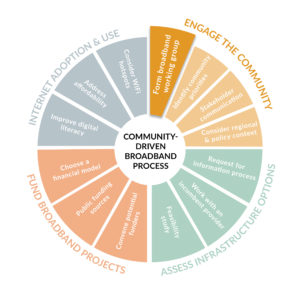
Like any community project, successfully improving internet connectivity takes the efforts of more than just one person. Forming a broadband working group, task force, or committee is a great way to pursue broadband improvements. Bringing together community members with diverse backgrounds can help with developing the community vision for its future, educating the broader community about broadband, and communicating the group’s efforts moving forward. In this way, working groups can help ensure that there’s community-wide support for resulting broadband projects.
HOW IT WORKS
Broadband solutions may require municipal involvement. This led the five dedicated residents who initiated a grassroots efforts on Long Island in Casco Bay to seek authorization from their local officials. While these residents intend to continue pursuit of broadband, they received municipal authorization as the Broadband Exploratory Committee to investigate broadband options and make a recommendation report to the select board. With more formality, the Town of Cranberry Isles select board authorized the Broadband Communications Working Group, which meets on set agendas to progress their broadband efforts.
Not all working groups are initiated or driven by local governments though. On Swan’s Island, residents initiated their broadband committee, by pulling together a diverse group that includes business owners, librarians, school officials, technical experts, health professionals, and also municipal officials. Cliff Island is part of the City of Portland, so residents there utilized an existing nonprofit, Sustainable Cliff Island. It was established to address the problems that threaten the sustainability of year-round residency on the island. Picking up the topic of broadband made sense in hopes of increasing employment options on the island, enabling and enriching educational opportunities, accessing government services, and facilitating the development of a telehealth facility.
Cliff and Long Islands, with Chebeague Island, joined forces to seek cost-efficiencies in a potential broadband solution, by appointing representatives from their individual working groups to a regional task force they call Down Bay Broadband. In addition to benefiting from each other’s skills, resources, and credibility, they are also able to leverage one another’s existing internet infrastructure for expansion of broadband to all three islands. Their aggregated voice (and potential customers!) can generate more attention from potential internet services providers.
KEY FACTORS
- Identify individuals. Assess the levels of interest and commitments from potential working group members, and seek a variety of expertise or perspectives. In addition to be respected residents, the Long Island Committee possesses information technology expertise. The Cranberry Isles Group is made of fishermen, librarians, technical experts, public safety and municipal officials, and business owners, who have strong relationships with school officials, historians, and telecommuters.
- Determine organization. Would a more or less formal meeting structure benefit the productivity of the working group or the reception of the working group’s outputs such as reports, presentations, or decisions? Working under an existing, umbrella mission, Sustainable Cliff Island was able to get right to work, setting up meetings with internet service providers to seek out the best broadband solution and raise the money to make it a reality. The formality of the Cranberry Isles Group helped ensure transparency of their actions and decisions, which supports efforts to garner broad community buy-in for their broadband project.
- Set an agenda. Verbalize the need and your goal. The Long Island Committee aims to support a stable year-round community, with great economic and social opportunities. The Swan’s Island Broadband Committee confirmed broadband goals of providing the ability to telework and supporting businesses, ensuring telehealth services, and providing for municipal public safety. Down Bay Broadband identified where their individual communities’ goals overlapped: desire to enable telecommuting, facilitate telehealth, support municipal services, and provide educational opportunities for decades to come.
- Meet regularly. In addition to a meeting schedule, set up a way to communicate between meetings. The Long Island Committee decided on weekly meetings, in order to synthesize information they had collected from various internet service providers and other broadband experts, as well as to strategize ahead of future meetings with providers. While meeting on an as needed basis, the Cranberry Isles Group members continued conversations using Slack, an online messaging system.
CHALLENGES
- Volunteers & level of priority. It can be hard to find people who are interested and have the time to commit. Broadband may not be the issue of the day, so you need to make the case for high-speed internet. What do they care about, and how is broadband related to that problem? While the lack of broadband may not be the most urgent problem, emphasize how every community member is impacted indirectly if not directly in their work, health, education, or quality of life.
- Timing. Try to hold meetings when the most people can attend as possible. Consider setting up a conference call option, which can also come in handy for bringing outside experts to the table.
- Staying positive. It can be challenging to maintain momentum when working group actions don’t have the desired outcome. Spread the work out among group members and celebrate each success no matter how small.
- Being patient. The pursuit of broadband will take months if not years. Try not to get discouraged when internet service providers aren’t able to respond very timely, or when funding deadlines don’t align well with local government meetings.
RESULTS
- By maintaining continuity from one meeting to the next, despite the members’ very busy lives, the Cranberry Isles Group ensures consensus is reached and well-communicated broadly, as they developed their action plan, which was overwhelmingly approved at their 2017 town meeting.
- With well-articulated community goals, the Long Island Committee garnered overwhelming support at a community meeting to continue moving forward in the pursuit of broadband.
- With so many, diverse members, the Swan’s Island Committee was able to conduct a successful community survey while also investigating their existing infrastructure.
- Visit the example “Identify Community Priorities” to learn more about Long Island’s meeting strategy or Swan’s Island community survey.
Originally published February 2017

